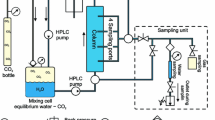Abstract
In investigating early karstification of one-dimensional conduits by computer models, so far one has assumed that the CO2 content of the calcite aggressive water stems entirely from the surface. Subterranean sources of CO2, however, can rejuvenate the solutional power of water already close to equilibrium with respect to calcite, and boost dissolution rates. In a first scenario we have investigated the influence of a punctual source of CO2 as the most simple case of release of CO2 into a karstifiable fracture at some position KL from its entrance of the widening joint with length L, (K<1). The results show that only a small increase of the p CO2 in the solution to about 0.01 atm is sufficient to reduce the breakthrough times to about 0.3 with respect to the case, where no CO2 is delivered. Other sources of CO2 are due to the metabolic activity of microorganisms. The existence of such diverse subterraneous microbial life in karst systems is demonstrated. Whether situated on the fissure surfaces or free floating in the karst water, one basic product of their metabolism is CO2. This contributes over the whole flow path to the p CO2 of the karst water. Therefore in a second scenario we assumed a constant rate of CO2-input along parts of the fracture, as could be delivered by the activity of aerobic bacteria dwelling at its walls. Such a scenario also applies to an extended diffuse CO2 migration from volcanic activity deep underground. In this case drastic reductions of the breakthrough time by about one order of magnitude are observed. These reductions are enhanced when the fracture aperture width of the initial fracture decreases. The physicochemical mechanisms of enhancement of karstification are discussed in detail by considering the evolution of the fracture aperture width and of the dissolution rates in space and time.
Similar content being viewed by others
Author information
Authors and Affiliations
Additional information
Received: 17 December 1998 · Accepted 23 April 1999
Rights and permissions
About this article
Cite this article
Gabrovšek, F., Menne, B. & Dreybrodt, W. A model of early evolution of karst conduits affected by subterranean CO2 sources. Environmental Geology 39, 531–543 (2000). https://doi.org/10.1007/s002540050464
Issue Date:
DOI: https://doi.org/10.1007/s002540050464




